Abstract
A mean-field statistical mechanical theory has been developed to describe molecular distributions in interphases. The excluded volume interaction has been modeled in terms of a reversible work that is required to create a cavity of the solute size against a pressure tensor exerted by the surrounding interphase molecules. The free energy change associated with this compression process includes the configuration entropy as well as the change in conformational energy of the surrounding chain molecules. The lateral pressure profile in a model lipid bilayer (30.5 A2/chain molecule) has been calculated as a function of depth in the bilayer interior by molecular dynamics simulation. The lateral pressure has a plateau value of 309 +/- 48 bar in the highly ordered region and decreases abruptly in the center of the bilayer. Model calculations have shown that for solute molecules with ellipsoidal symmetry, the orientational order increases with the ratio of the long to short molecular axes at a given solute volume and increases with solute volume at a given axial ratio, in accordance with recent experimental data. Increased lateral pressure (p perpendicular) results in higher local order and exclusion of solute from the interphase, in parallel with the effect of surface density on the partitioning and local order. The logarithm of the interphase/water partition coefficient for spherical solutes decreases linearly with solute volume. This is also an excellent approximation for elongated solutes because of the relatively weak dependence of solute partitioning on molecular shape. The slope is equal to (2p perpendicular - p parallel)/3KBT, where p parallel is the normal pressure component, and different from that predicted by the mean-field lattice theory. Finally, the lattice theory has been extended herein to incorporate an additional constraint on chain packing in the interphase and to account for the effect of solute size on partitioning.
Full text
PDF
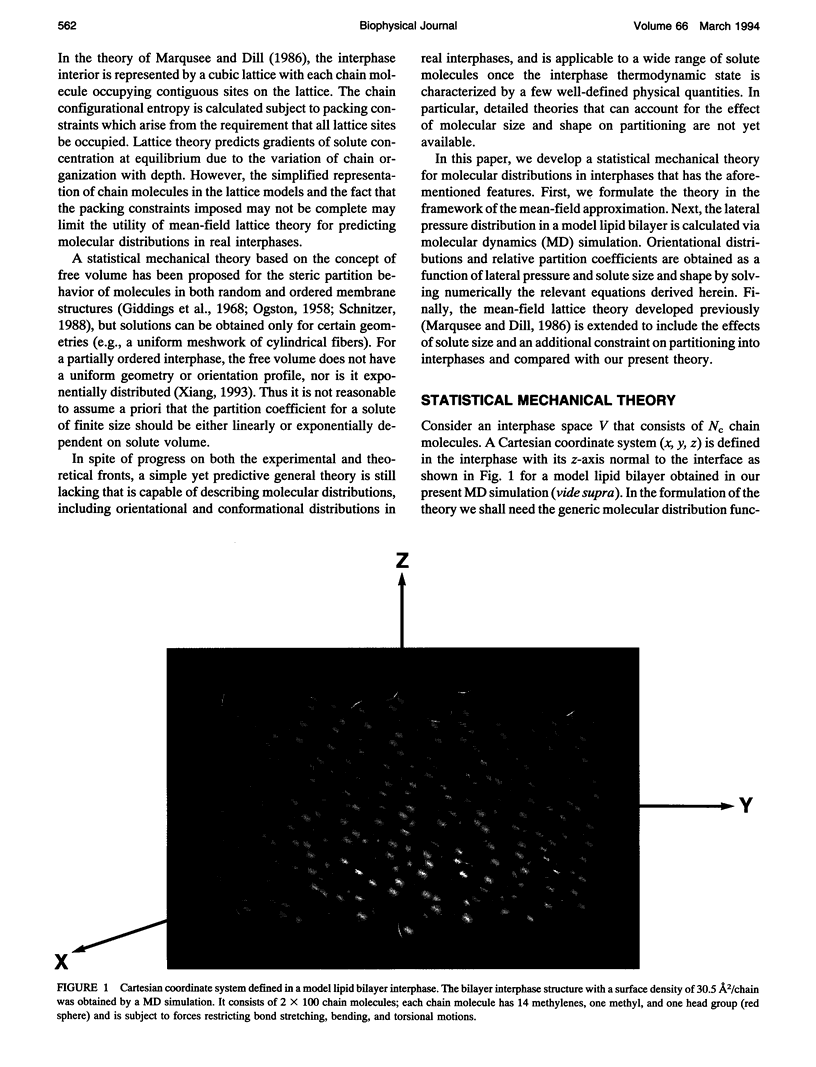
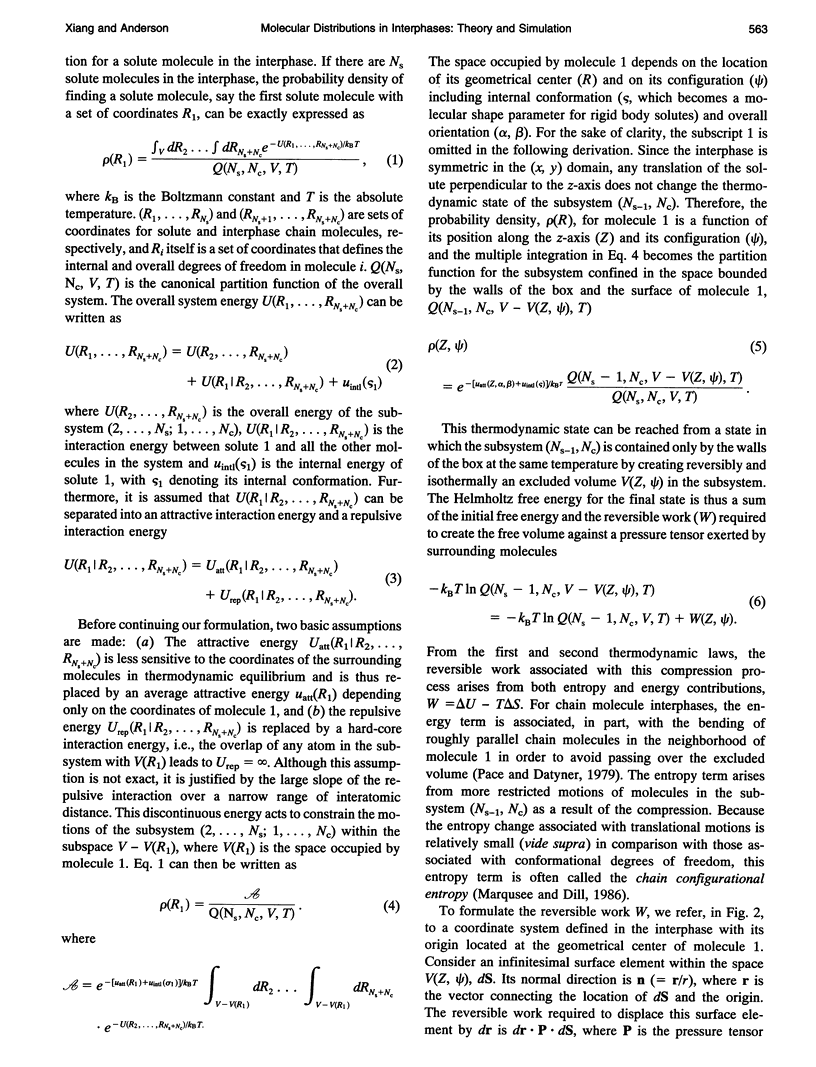


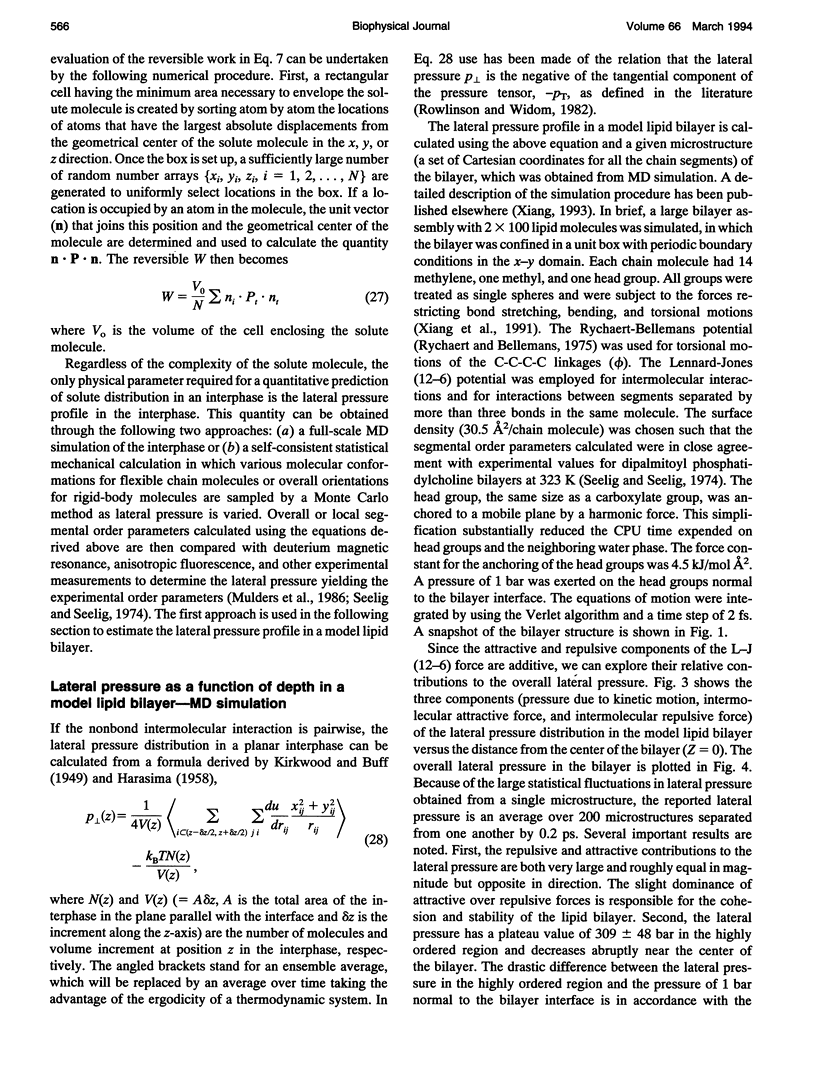
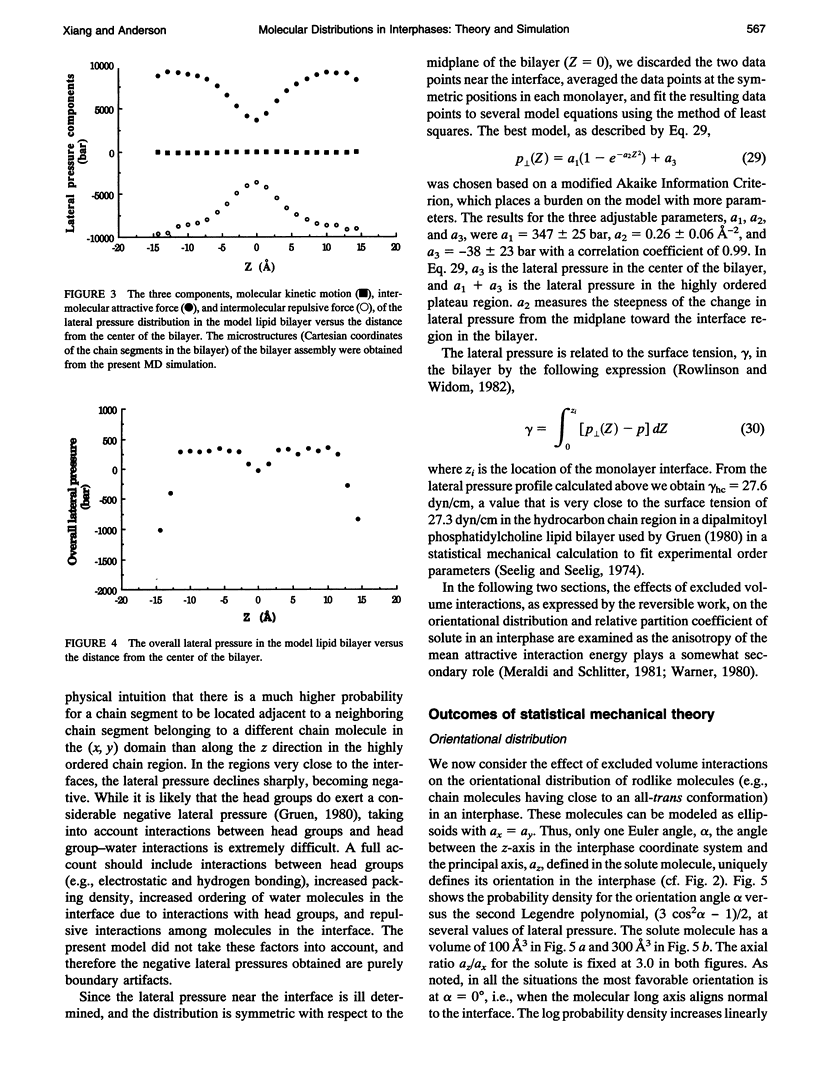




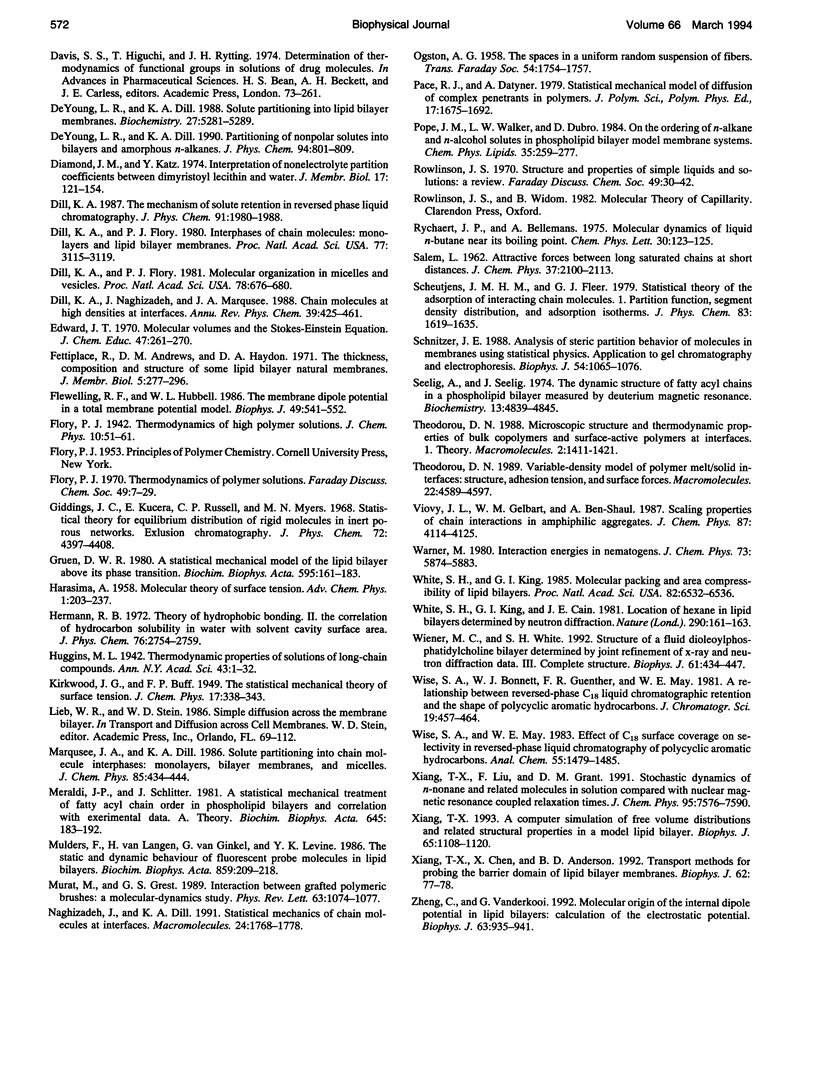
Images in this article
Selected References
These references are in PubMed. This may not be the complete list of references from this article.
- Ben-Shaul A., Szleifer I., Gelbart W. M. Statistical thermodynamics of amphiphile chains in micelles. Proc Natl Acad Sci U S A. 1984 Jul;81(14):4601–4605. doi: 10.1073/pnas.81.14.4601. [DOI] [PMC free article] [PubMed] [Google Scholar]
- De Young L. R., Dill K. A. Solute partitioning into lipid bilayer membranes. Biochemistry. 1988 Jul 12;27(14):5281–5289. doi: 10.1021/bi00414a050. [DOI] [PubMed] [Google Scholar]
- Diamond J. M., Katz Y. Interpretation of nonelectrolyte partition coefficients between dimyristoyl lecithin and water. J Membr Biol. 1974;17(2):121–154. doi: 10.1007/BF01870176. [DOI] [PubMed] [Google Scholar]
- Dill K. A., Flory P. J. Interphases of chain molecules: Monolayers and lipid bilayer membranes. Proc Natl Acad Sci U S A. 1980 Jun;77(6):3115–3119. doi: 10.1073/pnas.77.6.3115. [DOI] [PMC free article] [PubMed] [Google Scholar]
- Dill K. A., Flory P. J. Molecular organization in micelles and vesicles. Proc Natl Acad Sci U S A. 1981 Feb;78(2):676–680. doi: 10.1073/pnas.78.2.676. [DOI] [PMC free article] [PubMed] [Google Scholar]
- Dill K. A., Naghizadeh J., Marqusee J. A. Chain molecules at high densities at interfaces. Annu Rev Phys Chem. 1988;39:425–461. doi: 10.1146/annurev.pc.39.100188.002233. [DOI] [PubMed] [Google Scholar]
- Flewelling R. F., Hubbell W. L. The membrane dipole potential in a total membrane potential model. Applications to hydrophobic ion interactions with membranes. Biophys J. 1986 Feb;49(2):541–552. doi: 10.1016/S0006-3495(86)83664-5. [DOI] [PMC free article] [PubMed] [Google Scholar]
- Gruen D. W. A statistical mechanical model of the lipid bilayer above its phase transition. Biochim Biophys Acta. 1980 Jan 25;595(2):161–183. doi: 10.1016/0005-2736(80)90081-4. [DOI] [PubMed] [Google Scholar]
- Meraldi J. P., Schlitter J. A statistical mechanical treatment of fatty acyl chain order in phospholipid bilayers and correlation with experimental data. A. Theory. Biochim Biophys Acta. 1981 Jul 20;645(2):183–192. doi: 10.1016/0005-2736(81)90189-9. [DOI] [PubMed] [Google Scholar]
- Murat M, Grest GS. Interaction between grafted polymeric brushes: A molecular-dynamics study. Phys Rev Lett. 1989 Sep 4;63(10):1074–1077. doi: 10.1103/PhysRevLett.63.1074. [DOI] [PubMed] [Google Scholar]
- Schnitzer J. E. Analysis of steric partition behavior of molecules in membranes using statistical physics. Application to gel chromatography and electrophoresis. Biophys J. 1988 Dec;54(6):1065–1076. doi: 10.1016/S0006-3495(88)83043-1. [DOI] [PMC free article] [PubMed] [Google Scholar]
- Seelig A., Seelig J. The dynamic structure of fatty acyl chains in a phospholipid bilayer measured by deuterium magnetic resonance. Biochemistry. 1974 Nov 5;13(23):4839–4845. doi: 10.1021/bi00720a024. [DOI] [PubMed] [Google Scholar]
- White S. H., King G. I. Molecular packing and area compressibility of lipid bilayers. Proc Natl Acad Sci U S A. 1985 Oct;82(19):6532–6536. doi: 10.1073/pnas.82.19.6532. [DOI] [PMC free article] [PubMed] [Google Scholar]
- Wiener M. C., White S. H. Structure of a fluid dioleoylphosphatidylcholine bilayer determined by joint refinement of x-ray and neutron diffraction data. III. Complete structure. Biophys J. 1992 Feb;61(2):434–447. doi: 10.1016/S0006-3495(92)81849-0. [DOI] [PMC free article] [PubMed] [Google Scholar]
- Xiang T. X. A computer simulation of free-volume distributions and related structural properties in a model lipid bilayer. Biophys J. 1993 Sep;65(3):1108–1120. doi: 10.1016/S0006-3495(93)81156-1. [DOI] [PMC free article] [PubMed] [Google Scholar]
- Xiang T. X., Chen X., Anderson B. D. Transport methods for probing the barrier domain of lipid bilayer membranes. Biophys J. 1992 Jul;63(1):78–88. doi: 10.1016/S0006-3495(92)81581-3. [DOI] [PMC free article] [PubMed] [Google Scholar]
- Zheng C., Vanderkooi G. Molecular origin of the internal dipole potential in lipid bilayers: calculation of the electrostatic potential. Biophys J. 1992 Oct;63(4):935–941. doi: 10.1016/S0006-3495(92)81673-9. [DOI] [PMC free article] [PubMed] [Google Scholar]




